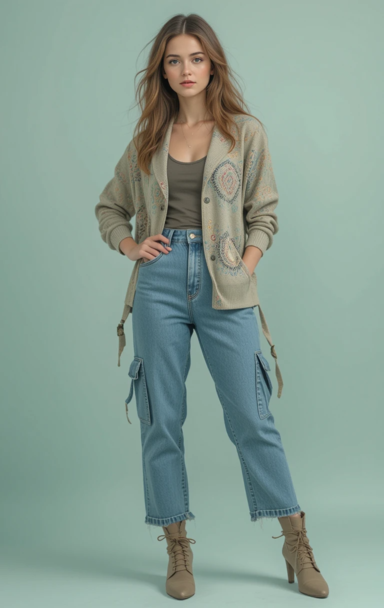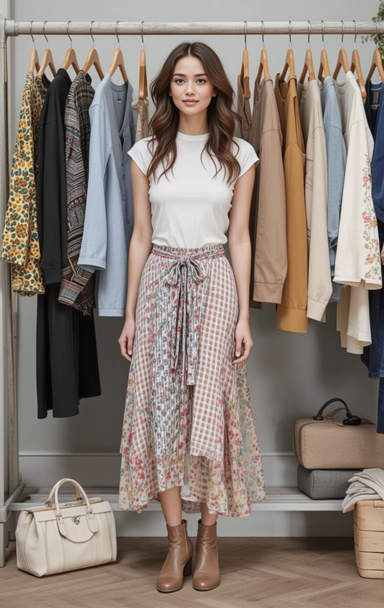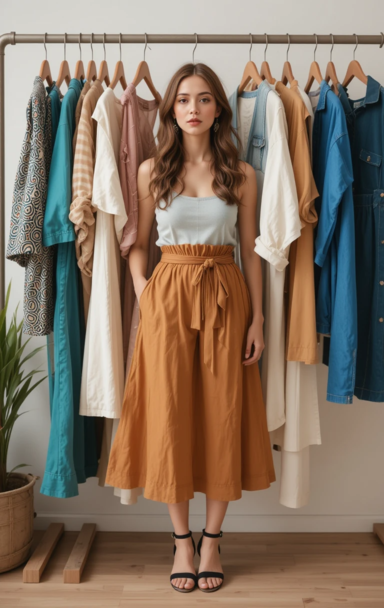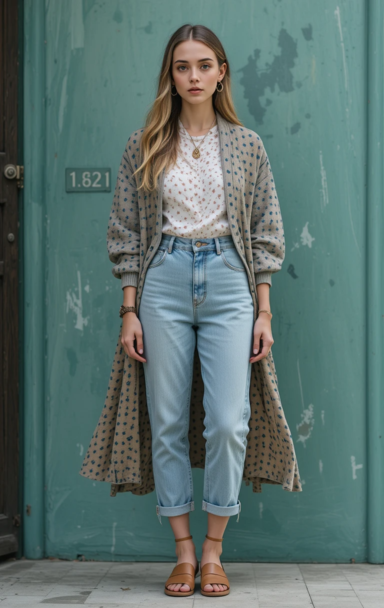In an era where environmental consciousness is increasingly becoming a priority, sustainable fashion has emerged as a critical component of the conversation surrounding climate change, consumerism, and the fashion industry. For many women, the desire to build a wardrobe that reflects their values—one that minimizes harm to the planet and embraces responsible choices—has led to the rise of eco-friendly fashion. But what does it truly mean to build an eco-friendly wardrobe, and how can women make choices that align with sustainability? This article will explore the fundamentals of sustainable fashion, its importance, and practical steps women can take to create an eco-conscious wardrobe.

Understanding Sustainable Fashion
Sustainable fashion is a broad and multifaceted concept, encompassing not just the materials used but also the processes of manufacturing, distribution, and disposal. In simple terms, it refers to clothing, accessories, and footwear that are produced, purchased, and disposed of in a way that reduces harm to the environment, respects workers’ rights, and promotes ethical labor practices.
While sustainability in fashion is often associated with using eco-friendly materials such as organic cotton, hemp, or recycled fabrics, it extends far beyond this. It includes:

- Ethical Labor Practices: Ensuring fair wages, safe working conditions, and respect for workers’ rights throughout the entire fashion supply chain.
- Circular Economy: Focusing on longevity, repairability, and recyclability in clothing production, as well as supporting the second-hand market.
- Resource Conservation: Reducing water and energy consumption, minimizing chemical use, and promoting waste reduction throughout the production process.
- Transparency and Accountability: Supporting brands that are transparent about their sourcing, production practices, and environmental impact.
In essence, sustainable fashion seeks to make clothing production and consumption more responsible by addressing the entire lifecycle of a garment—from raw materials to its eventual disposal.

The Environmental Impact of Fast Fashion
Before diving into the solutions, it’s essential to understand the problem that sustainable fashion is trying to solve: the devastating environmental impact of the fast fashion industry.
Fast fashion, characterized by cheap, low-quality garments produced at a rapid pace to follow ever-changing trends, has led to enormous environmental and social issues. Some of the key environmental concerns include:
- Water Usage: The fashion industry is one of the largest water consumers, with cotton production alone accounting for 2.6% of global water usage. The water-intensive nature of fabric production and dyeing processes, particularly in countries with limited water resources, contributes to water scarcity.
- Carbon Emissions: Fashion is responsible for approximately 10% of global carbon emissions, more than the aviation and shipping industries combined. The production of synthetic fibers, such as polyester, and the transportation of garments across the globe significantly increase the industry’s carbon footprint.
- Waste and Landfill Issues: The throwaway culture encouraged by fast fashion leads to massive waste. According to estimates, 92 million tons of textile waste are generated globally each year, with a significant portion ending up in landfills. Many of these garments are non-biodegradable and contain synthetic fibers that take hundreds of years to decompose.
- Chemical Pollution: The fashion industry’s use of harmful chemicals, including dyes and finishing agents, contaminates waterways and harms ecosystems. These chemicals can also pose risks to human health, particularly for those working in garment factories.
By shifting to a more sustainable fashion model, consumers can reduce their environmental impact, promote more ethical labor practices, and encourage companies to adopt more transparent and responsible practices.

The Importance of Sustainable Fashion for Women
The growing awareness of the negative impact of fast fashion has led many women to seek alternatives that align with their environmental values. But sustainable fashion isn’t just about making the “right” choice for the planet—it’s also about improving personal well-being and embracing values that extend beyond superficial trends.
- Empowerment: By choosing sustainable fashion, women can make more mindful purchasing decisions that align with their ethical values. Supporting ethical brands means investing in companies that prioritize environmental and social responsibility. This can foster a sense of empowerment and allow women to feel more connected to the global movement towards sustainability.
- Quality Over Quantity: Sustainable fashion often focuses on quality and longevity, which leads to a more thoughtful approach to consumption. Rather than purchasing cheap, low-quality garments that will wear out quickly, sustainable options encourage buying fewer, higher-quality items that last longer and require fewer replacements.
- Health and Well-being: Many eco-friendly fashion brands prioritize using natural materials that are free from harmful chemicals, such as organic cotton, bamboo, and hemp. These fibers are not only better for the planet but also gentler on the skin. Additionally, women who opt for sustainable fashion can often avoid wearing clothes that may contain toxic substances, such as formaldehyde, that are commonly found in fast fashion.
- Cultural Shifts: As more women embrace sustainable fashion, they become part of a larger movement that challenges the unsustainable, disposable culture promoted by fast fashion. By making mindful choices, women can inspire others and help drive positive change in the fashion industry.

How to Build an Eco-Friendly Wardrobe
Building a sustainable wardrobe requires thoughtful planning, intentional purchases, and a willingness to embrace changes in how we think about fashion. Here are some practical steps to help women create a more eco-friendly wardrobe:
1. Assess Your Current Wardrobe
The first step in building a sustainable wardrobe is evaluating what you already own. This involves:
- Decluttering: Take stock of your existing clothes and assess which pieces you truly wear and love. Donate, recycle, or repurpose items that no longer fit or suit your style.
- Quality Over Quantity: Examine the materials of your garments. Are they made from synthetic fibers like polyester, or do they feature high-quality natural fabrics like cotton, wool, and linen? Start making the shift toward better-quality items that can stand the test of time.
By reimagining your current wardrobe, you can reduce the urge to buy new clothes and get more mileage out of what you already own.

2. Buy Less, Choose Wisely
One of the most effective ways to build a sustainable wardrobe is to embrace conscious shopping. Some key practices include:
- Prioritize Longevity: Invest in high-quality pieces that are made to last. Look for timeless items—such as a well-made leather jacket, a simple white shirt, or a tailored coat—that will never go out of style.
- Choose Natural and Sustainable Fabrics: Look for clothing made from organic cotton, hemp, linen, wool, and silk. These fibers have a much smaller environmental footprint than synthetic fabrics like polyester, which are derived from petrochemicals and are non-biodegradable.
- Avoid Trends: Fast fashion thrives on quickly changing trends, but following them often leads to a cycle of constant consumption. Instead, opt for a capsule wardrobe, which focuses on a small selection of versatile, long-lasting pieces that can be mixed and matched.
- Check Certifications: Look for certifications like Fair Trade, Global Organic Textile Standard (GOTS), and OEKO-TEX Standard 100, which indicate that products are made with sustainable materials and ethical labor practices.

3. Support Sustainable and Ethical Brands
As a conscious consumer, it’s important to support brands that prioritize sustainability. Some things to look for in a sustainable fashion brand include:
- Transparency: A truly sustainable brand should be transparent about its supply chain, materials, and manufacturing processes. They should be open about where their clothing is made, how it’s produced, and the impact it has on the environment and workers.
- Ethical Labor Practices: Supporting brands that pay fair wages and treat workers with respect is a key component of sustainable fashion. Look for brands that commit to fair labor standards and create a positive working environment for employees.
- Innovative Materials: Many sustainable brands are at the forefront of innovation, using recycled or upcycled materials, plant-based fabrics, and eco-friendly dyes. Look for brands that are pushing the boundaries of sustainability in their products.

4. Buy Second-Hand and Vintage
Thrifting is one of the most effective ways to build a sustainable wardrobe. Buying second-hand clothing reduces the demand for new garments and diverts perfectly good items from landfills. Vintage and second-hand clothing often feature higher-quality materials that have stood the test of time.
- Charity Shops and Thrift Stores: Shopping at local charity shops or thrift stores can yield some hidden gems, from designer items to one-of-a-kind pieces. Not only does it help reduce waste, but it also supports charitable causes.
- Online Platforms: Online marketplaces such as Poshmark, Depop, and ThredUp allow you to shop for second-hand clothing from the comfort of your home. These platforms are excellent for finding gently used pieces and even vintage clothing.

5. Care for Your Clothes
Proper garment care can extend the life of your clothing and reduce the need for frequent replacements. Some eco-friendly care tips include:
- Wash Less: Washing clothes less frequently reduces water and energy consumption. Spot clean stains or air out clothes instead of washing them after every wear.
- Cold Water Washing: Washing clothes in cold water saves energy and helps preserve the integrity of the fabric.
- Air Drying: Instead of using a dryer, hang your clothes to air dry. This reduces energy consumption and helps your clothes last longer.

Conclusion: A Journey Towards Sustainable Fashion
Building an eco-friendly wardrobe is a gradual and ongoing process that requires conscious decisions, responsible shopping habits, and a shift in mindset. By investing in quality, supporting ethical brands, and embracing second-hand and vintage options, women can reduce their environmental impact while still expressing their unique style. Sustainable fashion isn’t just a trend—it’s a movement towards a more conscious and mindful way of living. Every choice, no matter how small, contributes to a more sustainable future for the fashion industry and the planet.



